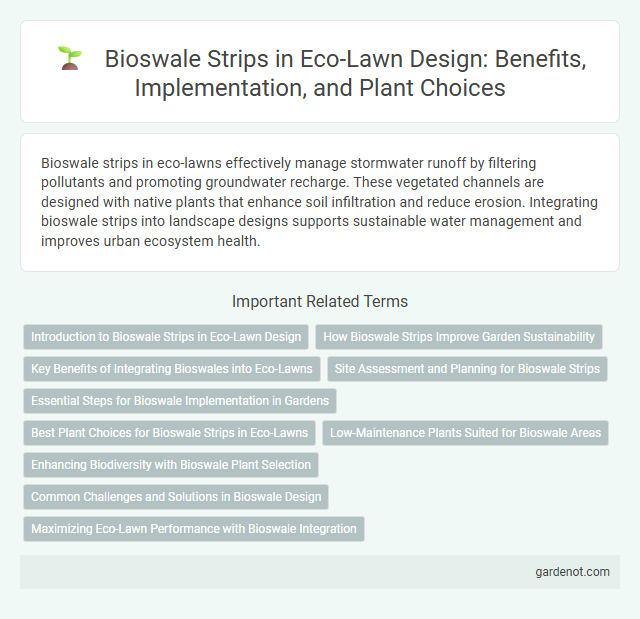Bioswale strips in eco-lawns effectively manage stormwater runoff by filtering pollutants and promoting groundwater recharge. These vegetated channels are designed with native plants that enhance soil infiltration and reduce erosion. Integrating bioswale strips into landscape designs supports sustainable water management and improves urban ecosystem health.
Introduction to Bioswale Strips in Eco-Lawn Design
Bioswale strips are essential components in eco-lawn design, serving as vegetated channels that efficiently capture and filter stormwater runoff. These strips utilize native plants and engineered soil media to promote infiltration, reduce erosion, and remove pollutants before water enters the drainage system. Integrating bioswale strips enhances sustainability by improving water quality and supporting local biodiversity within urban landscapes.
How Bioswale Strips Improve Garden Sustainability
Bioswale strips enhance garden sustainability by efficiently managing stormwater runoff, reducing soil erosion, and filtering pollutants before they reach groundwater. These vegetated channels promote water infiltration and support native plants, which increases biodiversity and reduces the need for irrigation. Implementing bioswale strips in eco-lawns encourages a healthier ecosystem and lowers maintenance costs by improving soil health and moisture retention.
Key Benefits of Integrating Bioswales into Eco-Lawns
Bioswale strips enhance eco-lawns by improving stormwater management through natural filtration and infiltration, reducing runoff and preventing soil erosion. They support biodiversity by providing habitats for native plants and pollinators, which strengthens local ecosystems. Integrating bioswales also promotes groundwater recharge and reduces the need for chemical fertilizers, contributing to sustainable lawn care practices.
Site Assessment and Planning for Bioswale Strips
Site assessment for bioswale strips involves evaluating soil permeability, topography, and existing vegetation to ensure optimal water infiltration and pollutant removal. Planning requires mapping stormwater flow patterns and identifying suitable locations that maximize runoff capture while minimizing erosion risks. Incorporating native, drought-tolerant plant species enhances bioswale functionality and supports local biodiversity.
Essential Steps for Bioswale Implementation in Gardens
Installing a bioswale strip in gardens begins with selecting an appropriate location that naturally collects stormwater runoff, ensuring effective water filtration and absorption. Excavation follows to create a gently sloping trench lined with permeable materials and filled with water-retentive soil mixed with native plants such as sedges, rushes, and wildflowers. Proper maintenance includes regular inspection for debris buildup, plant health monitoring, and seasonal adjustments to optimize stormwater management and support local biodiversity.
Best Plant Choices for Bioswale Strips in Eco-Lawns
Native grasses like switchgrass (Panicum virgatum) and wildflowers such as black-eyed Susan (Rudbeckia hirta) thrive in bioswale strips by enhancing water infiltration and filtering pollutants in eco-lawns. Deep-rooted plants including blue flag iris (Iris versicolor) improve soil stability and reduce erosion, crucial for effective stormwater management. Selecting drought-tolerant species like sedges (Carex spp.) supports resilience during dry periods while maintaining the bioswale's ecological function.
Low-Maintenance Plants Suited for Bioswale Areas
Low-maintenance plants suited for bioswale strips include native grasses like switchgrass and blue fescue, which excel at soil stabilization and water absorption. Sedges such as Carex and robust perennials like purple coneflower and black-eyed Susan thrive in fluctuating moisture conditions typical of bioswales. These species reduce maintenance by minimizing irrigation needs and enhancing pollutant filtration in stormwater management systems.
Enhancing Biodiversity with Bioswale Plant Selection
Bioswale strips incorporate native grasses, sedges, and wildflowers that attract pollinators such as bees and butterflies, significantly enhancing local biodiversity. Selecting plant species adapted to varying moisture levels supports diverse habitats and improves water filtration efficiency. Strategic bioswale plantings create ecological corridors that foster wildlife movement and increase urban ecosystem resilience.
Common Challenges and Solutions in Bioswale Design
Bioswale strips often face common challenges such as soil compaction, inadequate plant selection, and poor water infiltration, which reduce their effectiveness in managing stormwater runoff. Solutions include using deep-rooted native plants to improve soil structure, incorporating engineered soil media to enhance permeability, and designing swales with appropriate grading to optimize water flow and retention. Regular maintenance to remove sediment build-up and prevent clogging ensures long-term functionality and ecosystem benefits.
Maximizing Eco-Lawn Performance with Bioswale Integration
Integrating a bioswale strip with an eco-lawn enhances stormwater management by effectively capturing and filtering runoff, reducing soil erosion and nutrient pollution. The bioswale's vegetation supports native plant growth, boosting biodiversity and soil health within the eco-lawn system. Strategic placement of bioswales in landscape design maximizes water infiltration, conserves resources, and promotes sustainable lawn performance.
Bioswale strip Infographic

 gardenot.com
gardenot.com